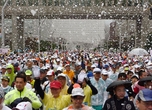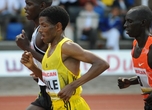
Posted: Mon Feb 21 2011
Meet Joseph Tame: British, 33, marathon runner, hugely eccentric. He'll attempt the Tokyo Marathon again this year (he managed it last year, though he was beaten by an septuagenarian — see below), but rather than do it dressed as a bear or something similarly cutesy, he'll be strapped into a contraption of his own devising. The iRun consists of four iPhones, a pair of Android handsets, an iPad, two weather censors, a heart monitor, a solar panel, and — just for good measure — a couple of children's windmills ("I tell people they charge the batteries, and they believe me"). Broadcasting the reams of data he'll be pumping out over his website, Joseph and his iRun hope to make history...of some kind...
You've done the Tokyo Marathon before, right?
I did the quarter marathon in 2009, and then in 2010 I did the full marathon. I was never a runner or an athlete, so it's all quite new to me.
How did you get on?
It was a nightmare! I remember reaching about 35 kilometres, approaching Odaiba, and there was this bridge with a very slight slope — something you wouldn't normally think about. I looked to my left and there was this elderly gentleman in his seventies, and he was walking over the bridge faster than I was running. That was shocking.
How heavy is the iRun?
It's about 3.7 kilograms.
Does that hinder you?
[Laughs] Yes it does! The thing is, at first it doesn't seem that heavy, but the further you go the heavier it gets, so it feels like it weighs about 15 kilos by the time you get to the end.
And you intend to interview other runners live, as you're running?
Yes. Last year we interviewed a lot of runners, international and Japanese. We had a Japanese chap performing a Japanese folk song on a guitar.
While running?
Yes, while running. No stopping. And we interviewed the TV celebrity, Bobby Ologun, which was quite funny because he was struggling as well.
How do you manage to interview and run at the same time? Aren't you in the process of dying?
[Laughs] Yes, well this is the thing; I have to do a constant, running commentary (pun intended) for the duration of the race. Basically, I just run at a pace where talking is possible. Obviously that means I'm running a lot slower than I usually do. But it's the only way to do it.
And when you're running at such tremendous speeds, how long do you expect it to take to complete the course?
[Laughs] Last year it took five hours and seven minutes. Normally, I think I can do it in about four hours, so [the broadcasting] adds at least 25 per cent of the total time.
Back to the iRun...doesn't it get funny looks when you're training in the street?
In Tokyo, people don't like to interact with complete strangers, I think. Even if you look quite interesting, people will just pretend they can't see you. However, because the iRun is so unusual, it pushes people beyond their usual boundaries. Some old women were asking about it on the train, and I said, "It's a live broadcasting rig." Their reaction was, "Ah, of course," as if it was the most obvious thing in the world! A lot of the parts for it come from Tokyu Hands, so I've spent several hours walking around the store picking up bits, while wearing it. Last time I went, I was mobbed by about 30 people pressing around me, asking questions, wanting to touch it. That's when I added the iPad, which has a scrolling banner on it explaining what the iRun is and what I'm doing with it.
Is there a charity aspect to all this?
There is, if people want to sponsor me. On my website there's a prominent link on the left to the Tyler Foundation, a Tokyo-based charity for children with cancer.
Is there anyone helping you with all this?
Of course! It's not just me. I have a team of about 15 to 20 volunteers who will be broadcasting all along the course from the spectators' perspective.
How did all of this pop into your head in the first place?
God knows. I love Apple devices — iPhones and iPads — and I just wanted to see how far we could push these things. Can we use these things to take live sports broadcasts to the next level? When you watch a marathon on TV, you're not really involved. It's a little bit boring, to be honest. So what I recommend to people is watching the marathon on TV, but having us on the computer, and then they can really feel like they're running it. I've got two videos, one facing forward and one facing my face, and you can see my heart rate, so when I do get really exhausted you'll know when to call an ambulance because it'll suddenly go flat. I'm relying on viewers to watch out for that.
Follow Joseph and his team via their website
Tweets
- About Us |
- Work for Time Out |
- Send us info |
- Advertising |
- Mobile edition |
- Terms & Conditions |
- Privacy policy |
- Contact Us
Copyright © 2014 Time Out Tokyo










 Top spots to watch the marathon
Top spots to watch the marathon Things to do that don't require fitness
Things to do that don't require fitness 10 marathon runners to lend your support to
10 marathon runners to lend your support to Top hotel deals for the 2011 Tokyo Marathon
Top hotel deals for the 2011 Tokyo Marathon Whacky racer: introducing the inventor of the iRun
Whacky racer: introducing the inventor of the iRun Return to the top page of the Tokyo Marathon guide
Return to the top page of the Tokyo Marathon guide



Add your comment